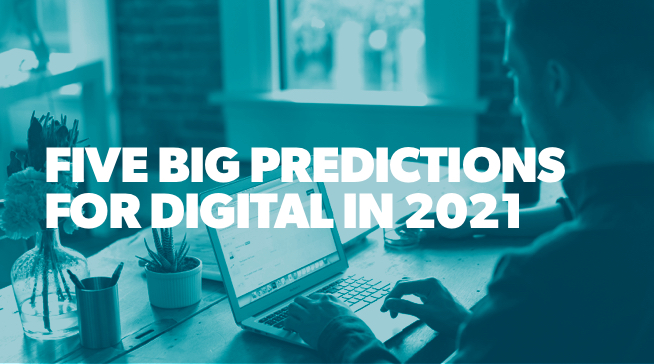With 2020 almost behind us, just what do the next twelve months have in store for the world of search, content and marketing? What lessons from 2020 will shape strategy and tactics in 2021, and how will both consumers and marketers change?
We put that question to the Zazzlers.
More targeted Ecommerce eCRM
Richard Marriott, Head of Zazzle Media

It’s without a doubt that ecommerce will continue to thrive in 2021. Once the dust starts to settle on what’s been a frantic year, a lot of brands need to rethink their eCRM strategies on how to really connect with their customers. Despite having more insight on consumers than ever before, as buyers we seemingly enter the same lacklustre cycle of visiting a site, entering a retargeting pool, getting hit with a barrage of emails and social ads that only serve to add to the noise of the estimated 5,000 pieces of content we consume every day.
Consumers expect and deserve more. Where I’m predicting to see a step change is in how ecommerce sites create better segmentation and customer buying journeys, tying that back into the content they deliver to their consumers. This in turn, will create better relevancy, the right level of frequency, consistency and type of content to deliver maximum engagement and, ultimately, ROI across all channels of their digital ecosystems.
An explosion of podcasting
Ellie Roddy, Senior Content Editor

Podcasts have seen a resurgence and subsequent steady increase in popularity over the last few years. But 2020 has made the incline in their popularity even steeper and I think we will continue to see this rapid growth in 2021.
The pandemic has meant creatives are at home, unable to do their regular day job and – as a result - many people turned to podcasts as a way to continue making content without leaving the house.
Louis Theroux, who we know for his hard-hitting and eye-opening documentaries, was among those looking for something new in March and it wasn’t long until he released Grounded with Louis Theroux. He, like many podcast hosts this year, discussed how his guests have dealt with 2020 – something listeners could relate to and find comfort in. BBC Sounds had record numbers listening during lockdown with Theroux’s being the most listened to.
According to a survey by Statista, in the first quarter of this year, one in three aged between 26 and 35 were listening to podcasts on a weekly basis. Advertising on these podcasts offers brands a way to reach their target market via a personality they trust – in a place they are far more receptive to it.
In January, DMA research found that 27% of podcast listeners discovered new brands via voice advertising. The UK podcast ad spend this year was already more than £33 million, as listener numbers only continue to grow, this is expected to reach £75 million by 2024. The podcasts released this year will have reached a whole new audience in a year when many people have had more time to listen.
Despite news of the vaccine, life won’t be going back to normal when the clock strikes 12 and takes us into 2021. Even when it does, I think the benefit of podcasts – both for those creating them and those listening to them – has already started to reach far more people and this will only continue to grow much faster. Once a habit forms, it can be hard to shake after all.
Diversity will reign across all media
Jade Lamb, Content Manager

In 2020, we were exposed to several societal issues that now need to be reflected in the content we create and carefully consider throughout the user journey. From the Black Lives Matter campaign, that continues to this day to support for the trans community, these are issues that have touched our lives like never before.
This means that, in 2021, we should expect to see marketers seeking out more diverse influencers on campaigns, creating content that talks to a wider audience and we may also witness the shunning of strict personas in tone-of-voice documents. Why limit yourself to just one type of demographic? You want people of all races, ages and sexual orientations to show an interest in your brand and what you offer.
Sadly, there will be hurdles to overcome. Just look at the backlash Sainsbury’s received for their 2020 Christmas advert that featured a family we’ve perhaps never seen portrayed before in such a prominent spot - but let's hope the reaction doesn't deter more brands from breaking down boundaries in 2021.
It’s something marketers will also need to train themselves to think about, looking beyond their own experiences to consider people that are not usually seen in the content we consume.
Nothing is daring about inclusivity, it’s something brands should have been doing since day one, but next year I think we’ll see a more encompassing and welcoming world of advertising than ever before.
Home working will see brands embrace collaboration apps, but they must focus on wellbeing
Tim Hopma, Design and Development Manager

2020 has proven, despite what many of the sceptics would have us believe, that remote working works. Businesses may have been forced into this culture change, but they’re now embracing it.
That shift has seen a lot of apps and software providers move to a much more real-time model of collaboration, particularly in areas like design and content creation. We’ve already seen it with Office 365 for content and the likes of Sketch and Figma in design, but the new remote working model will only drive this further in 2021. Embrace it wherever possible!
But the new home working paradigm does bring its challenges, and perhaps the biggest piece of the puzzle is around employee wellbeing. Home working doesn’t work for everyone and brands should (and I believe will) respond to this positively.
We should applaud those companies looking to be more responsible around carbon footprints and looking to move to a carbon neutral approach by reducing travel and commuting by encouraging remote working, as well as those engaged in initiatives like CO2 offsetting.
Audiences for digital mainstream and local media will grow
Louise Chapman, Senior Content Editor

Mainstream and local media have faced huge challenges in recent years, trying to pivot to a world of growing digital media consumption, but trusted outlets are needed more than ever.
With the growing realisation among audiences that misinformation is rife across the internet, trusted sources are picking up more views.
Sales of printed newspapers have been in decline for years and fell further during COVID 19, but consumption of news via apps and websites doubled, according to a Government Communication Service report.
The report said: “Local newspapers and their websites remained the top source for a local area, reaching four in ten consumers, closely followed by social media platforms, used by a third of consumers. UK adults spent a daily average of four hours and two minutes online during lockdown, up 30 minutes from six months previous.”
Whilst modern platforms, such as the video sharing platform TikTok and gamers’ live streaming platform Twitch, will continue to grow, sites run with full journalistic integrity such as mainstream media sites will also maintain their significance.
What people want in terms of news and communication isn’t likely to change. They want it to be trustworthy, easy to digest and timely. Marketeers who know how to make the messages of their clients fit that criteria to take them onto the news pages of mainstream media and local media sites will continue to be a valuable asset.
Sign up for our monthly newsletter and follow us on social media for the latest news.





 Proudly part of IPG Mediabrands
Proudly part of IPG Mediabrands